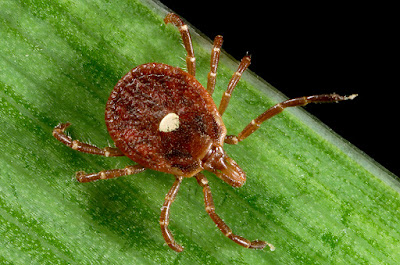 |
| A female lone star tick. |
Americans who want to enjoy the warmer weather of spring and summer better be careful of being in heavily wooded areas. A eight leg parasite is lurking in the tall grasses.
Whether you're cutting grass, hiking in the woods, climbing a tree or going to a beach, the bug is lurking.
The animal is called the long star tick. The bug is an arachnid that can bite you and spread a disease that can make you seriously allergic to red meat and milk.
The potentially life-threatening allergic reaction is called alpha-gal syndrome, or AGS. The Centers for Disease Control and Prevention says AGS can be triggered by a bite from a lone star tick, which are present in most areas of the U.S., though are less common up north and out west.
Animals like cows, deer, and lamb have AGS blood sugar, and the tick spreads it from animal to human.
Alpha-gal is a sugar molecule that’s found in most mammals and can also be found in their meat. Alpha-gal is found in pork, beef, lamb and venison. Allergic reactions include hives and rash, diarrhea, nausea, shortness of breath, low blood pressure, and swelling of the lips, throat, tongue and eyelids.
“It is one of those stranger-than-fiction kinda medical stories,” said Dr. Cosby Stone Jr., assistant professor of Vanderbilt Allergy and Immunology in Nashville, Tennesse. Stone and a research team have studied these unusual tick bites in children.
“I don’t like conspiracy theories,” said Stone. “But this is like the time when the conspiracy theory came true. And the tick bite turns you into someone that’s allergic to the food.”
AGS can be hard to spot. The symptoms often show up hours after eating red meat and the stomach pain often leads to a misdiagnosis of Irritable Bowel Syndrome.
Out of the 200 children Vanderbilt studied, 8% saw symptom relief by staying away from red meat.
 |
| The lone star tick stretches from Texas to Maine. It has appeared in Mexico and Canada. |
Previous research indicates treatment can include taking antihistamines and adjusting diets to avoid mammalian products. Over time and with physicians’ advice, people can re-introduce meats and mammal products back into diets.
Ticks are often found where deer rest or graze. It’s suggested to avoid those areas and do your best to keep deer out of your yard. Garlic and onions are two natural ways to scare them off.
The Connecticut Agricultural Experiment Station has a few ways to spot lone star ticks:
- Females have an obvious whitish dot on their backs
- Males don’t have the dot but have whitish markings at the edges of their bodies
- Nymphs (young) lone star ticks are more circular than adults, which are more egg-shaped. They’re also smaller than adults
CAES says the adult ticks are more active in spring and early summer, while nymphs are most active from April through summer. All lone star ticks are active in summer months. Both the CDC and other researchers warn lone star ticks are likely not the only ticks causing the spread of AGS.
“Alpha-gal allergies sort of broke all of our conventional rules as to what allergy is supposed to look like,” Stone said. “When you have a child that every now and again they are clutching their stomach, they’re throwing up and having diarrhea, and it happens regularly, that’s miserable for everybody.”
The lone star tick is an aggressive, generalist feeder; it actively pursues blood meals and is not specific about the species of host upon which it feeds. As already mentioned, A. americanum requires a separate animal or human host to complete each stage of its life cycle. The lifecycle begins when the blood-engorged adult female tick drops from her host, depositing around 5,000 eggs a few days later, once she has reached a safe and suitable location, such as in mulch or leaf litter. After an incubation period, larvae hatch from their eggs and undergo a quiescent (resting) period; this is followed by the pursuit of a host via questing. After feeding for one to three days, the blood-engorged larva dislodges from its host to digest its blood meal and molt into a nymph. The nymph follows this same pattern, attaching to a new host via questing and dropping from the host after its blood meal to molt into an adult tick. The female adult tick dies shortly after depositing her eggs.
Larval lone star ticks have been found attached to birds and small mammals, and nymphal ticks have been found on these two groups, as well as on small rodents. Adult lone star ticks usually feed on medium and large mammals, and are very frequently found on white-tailed deer. Lone star ticks also feed on humans at any stage of development.
The bites are painlessly and commonly going unnoticed. The tick remains attached to its host for as long as seven days or until it is fully engorged with blood.
No comments:
Post a Comment